Regarding parenting, ensuring our children’s proper development and safety is paramount. One of the most significant milestones in a baby’s growth is the transition from crawling to walking. Baby walking shoes play an essential role as they make this crucial shift. These shoes are designed to protect a child’s feet from the roughness of the ground and provide the support necessary for their developing muscles and bones.
Baby walking shoes are much more than miniature versions of adult footwear. They are engineered with the understanding that the bones in baby feet are soft and still forming. These shoes often feature flexible rubber or smooth leather soles, providing sufficient grip while allowing the foot to move naturally. This flexibility is crucial as rigid soles hinder a child’s ability to learn the natural toe-to-heel walking motion.
Adequate support is another cornerstone of baby walking shoes. They should stabilize the ankle without being overly restrictive, which can be achieved through soft, padded, yet supportive edges around it. This balance ensures that the shoes support a baby’s foot and ankle alignment, reducing the risk of injuries or improper walking habits forming early on.
The fit of baby walking shoes is equally important. They should fit snugly but not tightly, with enough room for the toes to move freely. This room is not just for comfort; it’s necessary for sensory feedback, which helps develop motor skills as babies feel the ground beneath them and adjust their balance accordingly.
Comfort and style are also crucial factors. Manufacturers now offer designs ranging from simple and functional to stylish models that mimic popular adult trends. This variety ensures a shoe to match every outfit and occasion, encouraging parents to keep their children appropriately shod as they explore the world on their feet.
Baby walking shoes are critical to a child’s early development. They provide the necessary support, flexibility, and protection to help little ones build confidence and skills in walking. Choosing the right pair is a blend of science and style, ensuring our children are safe and fashionable as they take their first steps into the world.
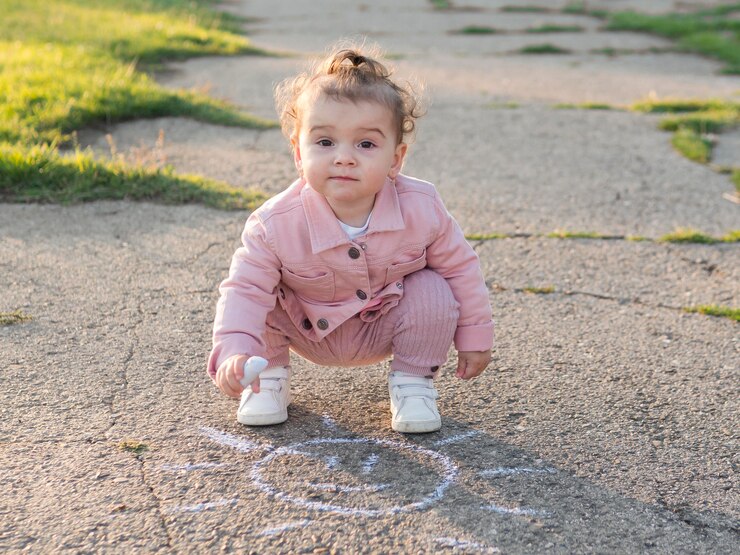
The Importance of Baby Walking Shoes
As babies grow and explore the world on their feet, choosing the proper footwear becomes crucial for their development. Baby walking shoes are essential in supporting and protecting their delicate feet during this formative period.
When babies begin to walk, they develop their feet and leg muscles. Babies’ walking shoes are made to offer the necessary support without hindering their natural foot movement. Unlike regular shoes, baby walking shoes are built with flexible soles and ample room to move and grow. This flexibility ensures that the boots bend with the baby’s foot, allowing for natural movement and improving balance and coordination.
Protection is another significant benefit of best baby walking shoes. As infants navigate various surfaces, from indoor carpets to outdoor playgrounds, their shoes protect them from sharp objects, uneven ground, and harsh temperatures. The right walking shoes are constructed using sturdy materials to resist deterioration from a baby’s daily adventures. Moreover, they have non-skid soles, which reduce the risk of slipping, thus making walking safer for those just learning.
Comfort is vital in baby walking shoes. Young children are more sensitive to discomfort, which can distract them from walking or discourage them from trying. Good baby walking shoes are made from breathable materials to keep the feet fresh and prevent irritation. They should be easy to put on and take off yet secure enough to stay on the baby’s feet throughout the day. Proper fit is crucial; shoes that are too tight can restrict growth, while those too loose can cause falls.
Choosing the right baby walking shoes also involves considering how they affect foot development. Pediatricians often recommend soft-soled shoes for new walkers as they mimic barefoot walking, promoting better grip and muscle growth. Babies become more proficient walkers and can transition to shoes with more structure and support.
In conclusion, investing in the right baby walking shoes is essential for any parent. These shoes provide support, protection, and comfort and assist in the healthy development of a child’s ability to walk. When selecting walking shoes, parents should look for flexible, breathable, and well-fitting options to encourage their little ones to explore the world confidently and safely.
This article aims to highlight the critical aspects of baby walking shoes in supporting the developmental milestones of new walkers.
When Choosing Baby Walking Shoes:
When choosing baby walking shoes, it’s essential to consider several key factors to ensure your child’s comfort, support, and safety as they take their first steps. Here, we outline the vital rules, focusing on finding the perfect baby walking shoes.
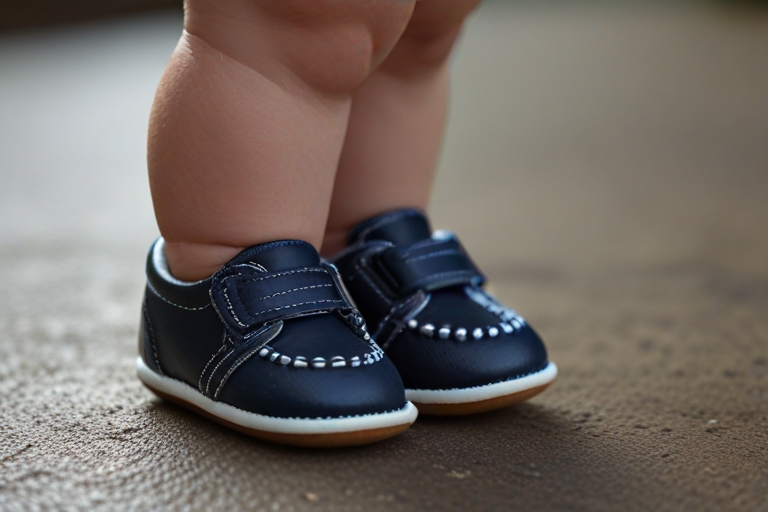
Comfort and Fit: The Foundation of a Good Pair of Shoes
The first rule in selecting baby walking shoes is ensuring they fit comfortably. A good fit means the shoe should have about a thumb’s width of space beyond the longest toe to permit development and motion. The shoes should be easy to put on but secure enough not to slip off. Soft, breathable materials like leather or canvas help prevent irritation and allow proper ventilation, which is crucial for a baby’s sensitive skin.
Support and Stability: Promoting Balance and Confidence in Early Walkers
Support and stability are vital when selecting baby walking shoes. Shoes featuring a strong heel stopper and a flexible sole at the football help stabilize and support the baby’s feet. This encourages balance and confidence in early walkers by providing the proper support without impeding their natural foot movement. Ankle support is also essential to avoid wobbling and provide a secure base for your child as they explore walking.
Material Matters: Optimal Fabrics and Construction for Baby Shoes
The choice of material for baby walking shoes impacts their overall effectiveness and comfort. Opt for non-toxic, high-quality materials that are durable and provide comfort. Fabrics like genuine leather or high-grade synthetic materials offer durability and flexibility. The shoe’s construction should also be robust, with non-irritating seams and soft linings to ensure comfort and prevent blisters or other discomforts.
Flexibility and Traction: Facilitating Natural Movement and Safety
Flexibility in baby walking shoes is crucial to facilitate natural foot movements. The soles should be soft and pliable, bending with the baby’s foot as they walk. This flexibility aids in the development of proper foot muscles and coordination. Traction is equally essential; look for shoes with non-slip soles that provide grip but won’t catch on the ground, which may cause trips and falls. Ls. Good traction helps your baby navigate various surfaces safely and confidently.
In conclusion, when shopping for baby walking shoes, prioritize comfort, support, suitable materials, and the right balance of flexibility and traction. By following these guidelines, you can ensure that your child’s first steps are supported by shoes that promote healthy foot development and offer the confidence to explore their world on foot.
Exploring Nike Baby Walking Shoes
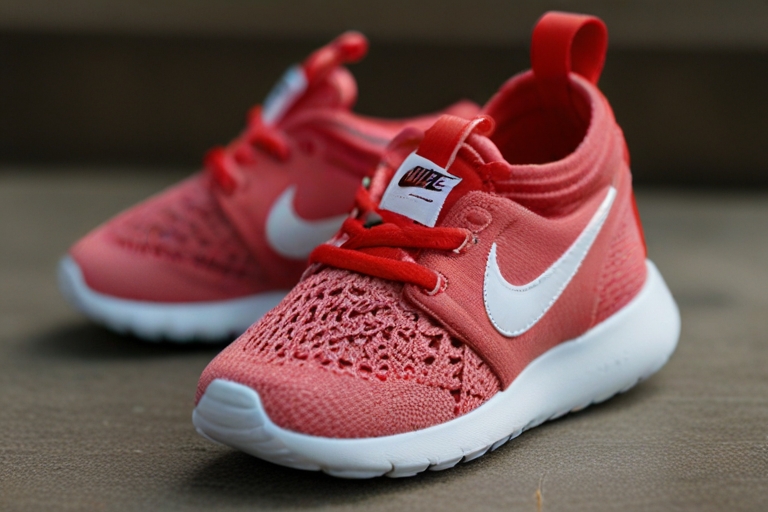
Nike: A Trusted Name in Footwear Innovation
Nike has long been synonymous with pioneering innovations in the footwear industry. Known for its dedication to enhancing athletic performance and comfort, Nike also brings this expertise to its range of footwear for the youngest walkers. Their commitment to excellence and creativity guarantees that every pair of shoes supports the needs of growing feet, making them a top choice for parents worldwide.
Nike Baby Walking Shoes: Blending Style with Functionality
Nike’s baby walking shoes are designed to provide the perfect blend of style and functionality. With adorable designs that mirror the trends seen in adult athletic footwear, these shoes make a fashion statement while ideally suited to the developmental needs of babies taking their first steps. Made with breathable materials and flexible soles, they offer comfort and freedom of movement, which is crucial for the exploration phase of young toddlers.
Features and Benefits: What Sets Nike Baby Walking Shoes Apart
Flexibility: Soft, bendable soles allow for natural foot movement, essential for developing balance and coordination.
Support: Structured heel cups and secure closures keep the feet stable. Durability: High-quality materials ensure that the shoes withstand the rigors of use by active toddlers, making them durable enough to be handed down.
Safety: Non-slip soles provide the traction needed to prevent falls, giving parents peace of mind as their children navigate various surfaces.
These features collectively make Nike baby walking shoes a superior choice, ensuring the child’s first steps are safe, comfortable, and stylish.
Customer Reviews:
Customer reviews consistently highlight the satisfaction among parents with Nike’s baby walking shoes. Many parents note the ease with which their children adapt to wearing these shoes, praising their comfort and the stability they provide. Reports often mention that children who wear Nike baby walking shoes seem more confident in their walking, likely due to the excellent support and traction offered. Positive feedback also frequently comments on the longevity and wear-resistance of the shoes, a testament to their quality and the value they provide.
In sum, Nike’s baby walking shoes are highly recommended for parents seeking a reliable, stylish, and functional choice for their child’s early steps.
Baby’s First Walker Shoes: Catering to New Walkers’ Needs
Baby walking shoes are crucial for toddlers transitioning from crawling to walking. The proper footwear supports this developmental milestone and protects their sensitive feet while providing flexibility and stability. For new walkers, shoes with soft, breathable materials and non-slip soles are ideal, ensuring comfort and safety as they explore their surroundings.
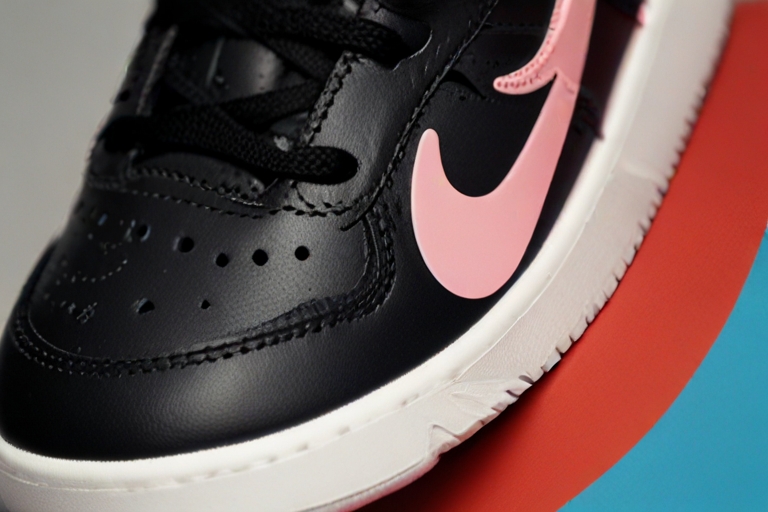
Brands and Styles:
While Nike offers a range of baby walking shoes, numerous other brands cater to young walkers with various styles and functionalities. Brands like Stride Rite and Pediped offer shoes designed specifically for a baby’s first steps, focusing on orthopedic support and using flexible, non-constricting materials. Each brand brings a unique aesthetic and functional approach to baby footwear, offering parents various choices beyond the mainstream options.
Comparing Popular Brands:
When comparing brands, it’s essential to consider several factors to find the perfect pair of baby walking shoes. Stride Rite shoes are often recommended for their deep understanding of baby foot development, offering shoes with rounded soles for better balance. Pediped, on the other hand, is known for its award-winning designs that mimic barefoot walking, which is beneficial for muscle development in young children. Reviewing these aspects can help parents make an informed decision based on their baby’s specific needs and walking stage.
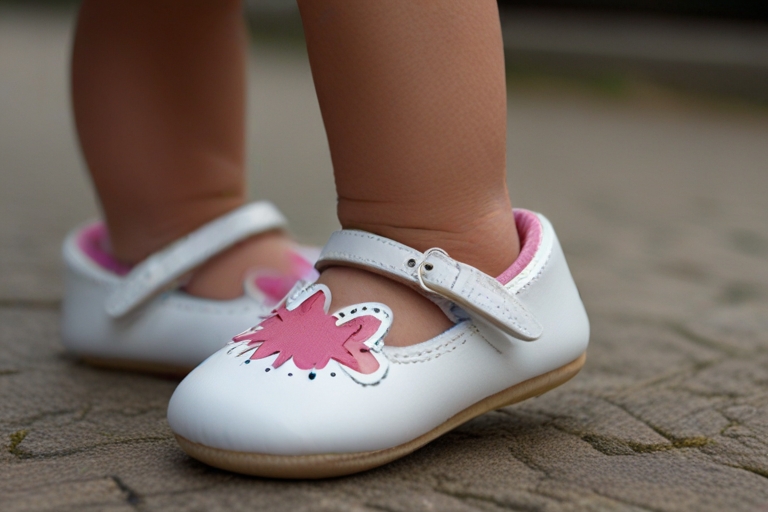
Tips for Buying Baby’s First Walking Shoes: Expert Recommendations
Experts recommend choosing lightweight baby walking shoes with a flexible sole for natural foot movement. Selecting shoes with a breathable upper material is crucial to keep your baby’s feet cool and dry, lowering the possibility of pain or skin irritations. Additionally, shoes with adjustable closures such as Velcro can accommodate different foot widths and ensure a secure fit, essential for babies learning to walk. Always measure your baby’s feet before purchasing new shoes; proper fit is critical to supporting healthy foot development.
Tips for Caring for Baby Walking Shoes
When caring for baby walking shoes, there are a few essential tips to keep in mind to ensure that these tiny shoes remain in good condition and provide the best support for your baby as they explore the world on foot. Here are some guidelines for cleaning and maintenance, sizing and growth, and rotation and replacement.
Cleaning and Maintenance: Preserving the Quality and Hygiene of Baby Shoes
Baby walking shoes can get dirty quickly, but proper cleaning and maintenance can preserve their quality and hygiene. Start using a soft brush or cloth to remove dirt from the surface. If the shoes are machine washable, ensure they are placed in a mesh laundry bag and washed gently with mild detergent. Air drying is preferable as high heat can damage the shoes. Use a cleaner appropriate for leather shoes and condition them occasionally to prevent the material from drying out and cracking. Always ensure the shoes are completely dry before putting them back on your baby’s feet to prevent the growth of bacteria and odor.
Sizing and Growth: Ensuring Proper Fit as Your Baby Grows
It’s crucial to regularly check the fit of your baby’s walking shoes. Babies’ feet proliferate, and shoes that are too small can restrict growth and cause discomfort. Ideally, there should be about a thumb’s width between the front of the shoe and your baby’s longest toe while standing. This space allows for growth and movement. Make it a habit to check the fit every month or two, as tight shoes can be uncomfortable and hinder proper foot development.
Rotation and Replacement: Maximizing the Lifespan of Baby Walking Shoes
To maximize the lifespan of baby walking shoes, having more than one pair at a time is beneficial. Rotating shoes allows them to air out, reducing the accumulation of germs and moisture, which can result in wear and tear. Additionally, inspect shoes regularly for signs of wear, especially in areas like the sole and toe, which can have a lot of impact as your baby walks. Replace shoes that show signs of wear, as worn-out shoes can affect the support and protection they offer your baby’s developing feet.
By following these tips for cleaning and maintenance, ensuring proper sizing and growth, and rotating and replacing baby walking shoes, you can help keep your baby’s feet healthy and supported as they take each new step. Remember, the proper care for baby walking shoes extends their life and contributes to the healthy development of your baby’s walking abilities.
Frequently Asked Questions About Baby Walking Shoes
1. When should my baby start wearing walking shoes?
Babies typically only need shoes when walking outdoors or on rough surfaces. Once your baby takes their first steps, consider getting them their first pair of walking shoes.
2. What should I look for in baby walking shoes?
Look for shoes that are flexible, lightweight, and breathable. The soles should be non-slip, provide good grip, and be flexible enough to allow natural foot movement.
3. How do I know if the shoes fit my baby correctly?
Ensure there’s about a thumb’s width between the end of the shoe and your baby’s longest toe. The shoes should be snug but not tight, allowing your baby’s feet to move without restriction.
4. How often should I check my baby’s shoe size?
Babies’ feet grow fast, so check their shoe size every 2-3 months. Look for signs like red marks on their feet or toes that curl downward, which suggest it’s time for a bigger size.
5. Can my baby wear second-hand walking shoes?
It’s best to avoid second-hand shoes for babies learning to walk. Shoes mold to the wearer’s feet, and worn shoes may not provide the proper support for a developing walker.
6. Are bare feet better for my baby indoors?
Yes, walking barefoot helps babies improve their balance and coordination by allowing them to feel the ground. It’s safe and beneficial for babies to walk barefoot indoors.
7. What materials are best for baby walking shoes?
Leather or canvas is excellent as it allows the feet to breathe and is durable. Avoid materials that don’t offer much breathability, like plastics or other synthetics.
8. Should baby walking shoes have arch support?
Most babies don’t need arch support. Pediatricians often recommend flexible, flat shoes that mimic the foot’s natural flexibility.
9. How can I make shoe-wearing a positive experience for my baby?
Let your baby practice wearing shoes for short periods at home. Ensure the shoes are comfortable and provide positive reinforcement when they attempt to walk in them.
10. Are there any signs that shoes are unsuitable for my baby?
If your baby consistently tries to remove the shoes, it could be a sign of discomfort. Also, watch for any changes in their walking pattern or complaints about their feet, which could indicate the shoes are not fitting correctly.
These questions cover most parents’ primary concerns when choosing and using walking shoes for their babies. Consider comfort, safety, and flexibility to support your baby’s natural foot development.
Tips for Encouraging Your Baby to Walk
Encouraging your baby to take their first steps is a thrilling milestone. Creating a nurturing environment that fosters mobility and confidence is essential to support their journey. Here are some tips to help your baby begin walking, focusing on choosing the right **baby walking shoes** and other supportive strategies.
Creating a Safe Environment for Exploration
The first step in encouraging your baby to walk is to ensure they have a safe space to explore. Remove any sharp objects or hazards from where your baby will practice walking. Soften hard edges with padding and ensure the floor is clean and free of small objects that could be a choking hazard. A clutter-free space allows your baby to move freely and safely, reducing the risk of injuries.
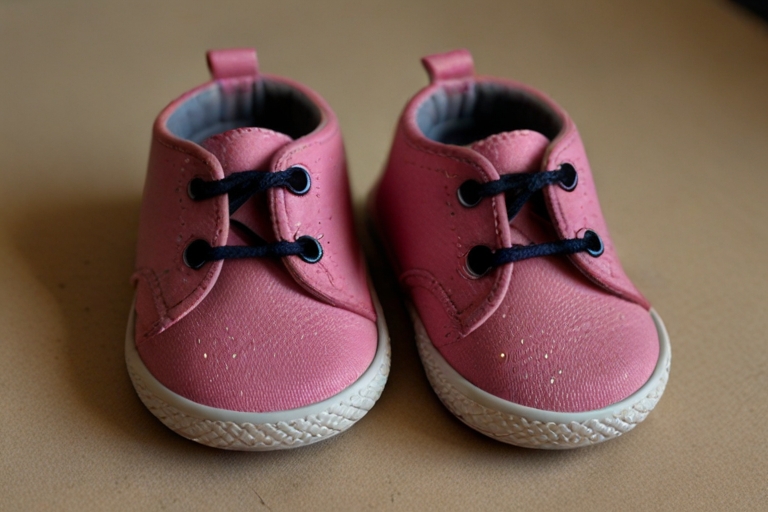
Using Supportive Aids: Walkers, Push Toys, and More
Supportive aids like walkers and push toys can be beneficial in encouraging your baby to walk. These aids help strengthen the leg muscles and provide the necessary support as your baby develops balance and coordination. When selecting a walker, ensure it is sturdy and has speed adjusters to prevent it from moving too fast.
Choosing the right **baby walking shoes** is also crucial. Look for shoes that are lightweight, flexible, and have a non-slip sole to prevent falls. The shoes should provide adequate support without restricting the natural movement of your baby’s feet. The shoes must fit well, with about a thumb’s width of space between the toe and the end of the shoe to allow for growth and movement.
Celebrating Milestones: Encouraging and Praising Your Baby’s Efforts
Every small step your baby takes is an achievement that should be celebrated. Encouragement and praise are powerful tools in motivating your baby to continue practicing their walking skills. Cheer for them every time they stand or make a step, and offer plenty of smiles and applause to reinforce their efforts.
Additionally, you can encourage walking by placing toys a little out of reach, so your baby has to move toward them. Always supervise your baby during these activities to ensure they are safe and supported.
In summary, fostering an environment that encourages your baby to walk involves:
- Ensuring a safe and open space.
- Using the right supportive aids like **baby walking shoes** and walkers.
- Celebrating each of your baby’s milestones with enthusiasm and pride.
With patience and the right tools, your baby will be walking quickly!
In conclusion, selecting the right baby walking shoe is crucial in supporting your child’s development as they take their first steps. As parents navigate the myriad of options available in the market, focusing on shoes that offer comfort, safety, and proper support is essential, rather than merely aesthetic appeal. The ideal baby walking shoe should have a flexible sole that mimics barefoot walking, providing a natural grip and enhancing the baby’s ability to balance. Moreover, breathable materials like soft leather or canvas are preferable to keep the baby’s feet cool and dry, preventing discomfort and potential skin issues.
Additionally, choosing the correct size is paramount. Too-small shoes can impede growth and be uncomfortable. At the same time, those too large can hamper your baby’s ability to walk correctly and increase the risk of falls. Parents should seek professional help or use reliable sizing guides to ensure a perfect fit. Furthermore, selecting shoes with adjustable closures such as Velcro is beneficial, as they can be easily modified to fit snugly around your baby’s feet and accommodate their rapid growth.
The impact of the right walking shoes on a child’s development should not be underestimated. Proper footwear can provide the necessary support for a baby’s first steps. It is also essential for safeguarding their feet from external elements and injuries as they explore their surroundings. Parents should look for signs of wear and change the shoes to adapt to their child’s growing feet and evolving needs.
In making this significant purchase, parents are encouraged to consider recommendations from pediatricians or orthopedic specialists who understand the biomechanics of children’s feet. Parents can provide a solid basis for their children’s walking patterns by investing in high-quality baby walking shoes, contributing to healthier foot development and overall mobility.
In summary, while finding the perfect baby walking shoe might seem daunting, it is a worthwhile endeavor. Parents can provide their children with the best possible support as they embark on the incredible walking journey by prioritizing function over fashion, ensuring a proper fit, and choosing breathable and flexible materials.


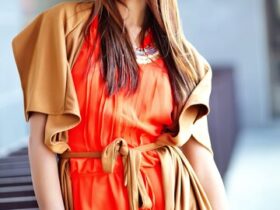
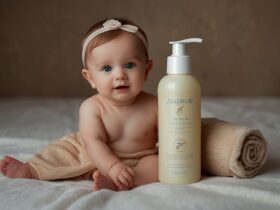



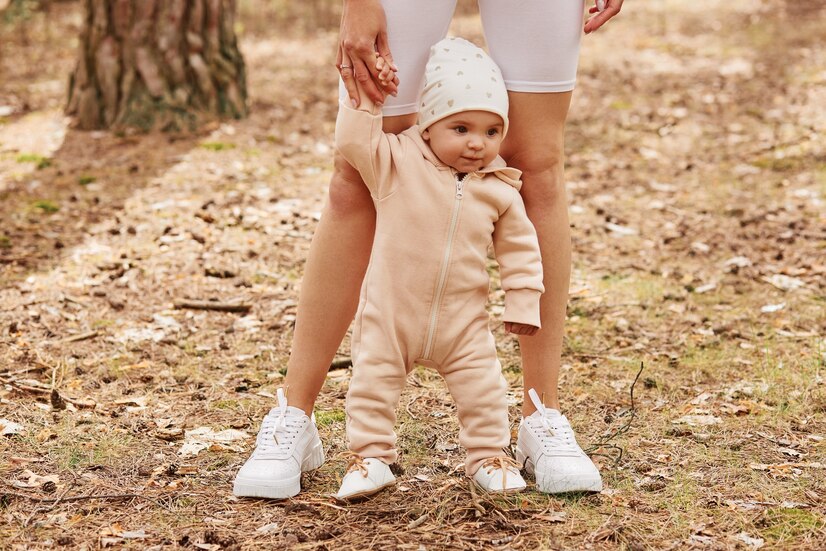
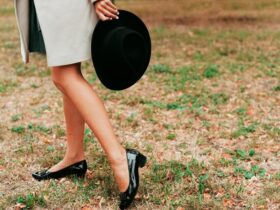


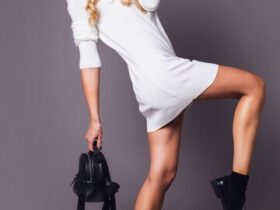

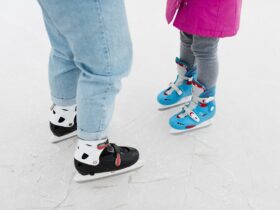
Leave a Reply
View Comments